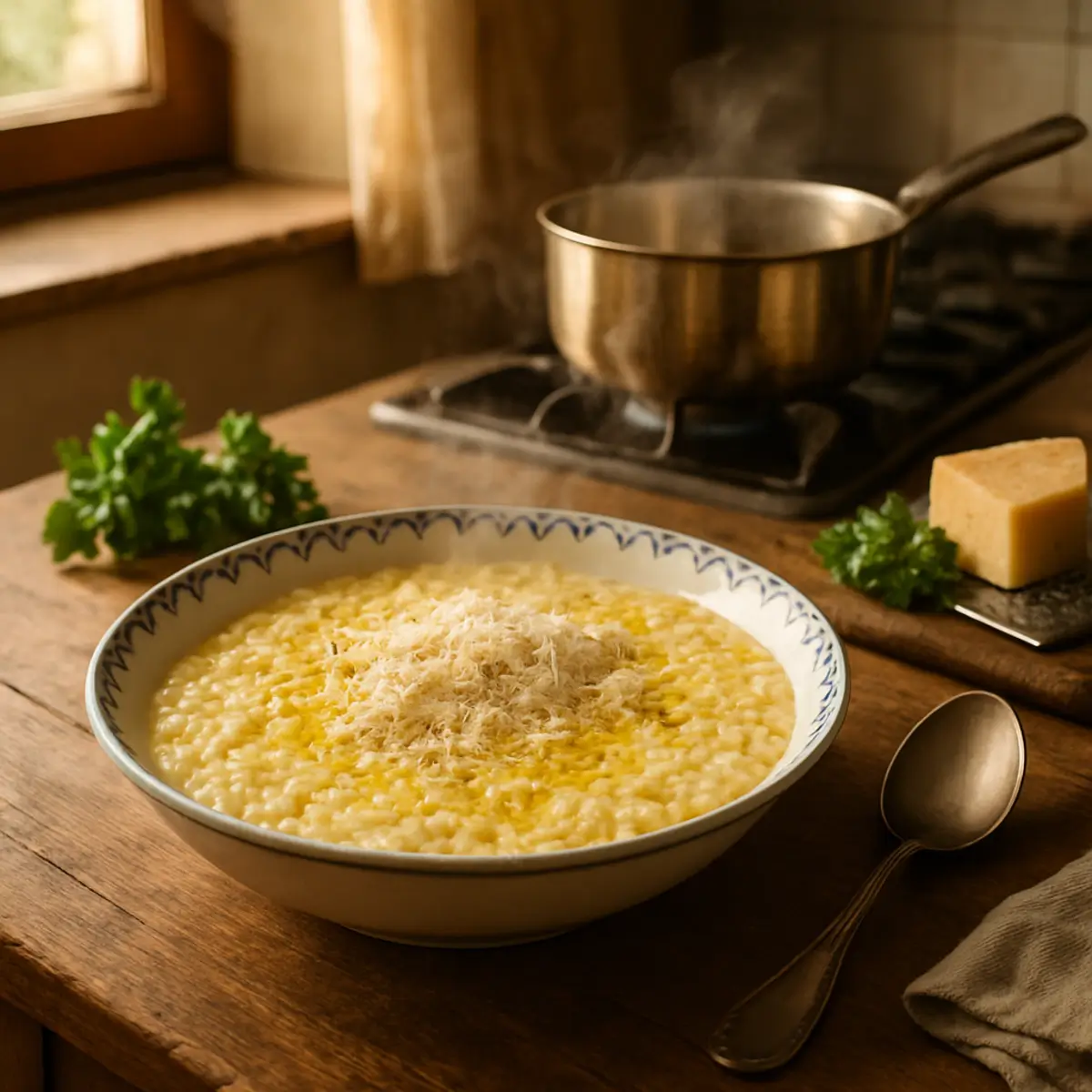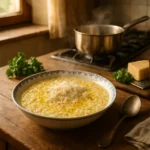Introduction
There’s a reason why every Italian kitchen holds a special place for a simple bowl of pastina. Imagine a dish so comforting, so universally beloved, that it’s called “Italian penicillin” and has soothed generations through childhood sniffles, heartbreak, and cold winter nights. The humble pastina recipe is more than just a meal—it’s a warm hug in a bowl, a taste of nostalgia, and a testament to the beauty of simplicity in Italian cooking.
In this guide, you’ll discover the heart and soul of pastina, learn how to make the classic version, explore variations, and hear personal stories that reveal why this dish is cherished across generations. Whether you’re seeking an easy pastina recipe for a quick weeknight dinner or looking to recreate the flavors of your childhood, you’ll find everything you need here.

Table of contents
Table of Contents
What is Pastina?
Pastina translates from Italian as “little pasta,” and that’s exactly what it is—tiny pasta shapes, often stars (stelline), dots (acini di pepe), or small rings (annellini), that cook in minutes and absorb the flavors of whatever they’re paired with. While pastina is most often associated with a simple broth-based soup, its uses are as varied as the shapes themselves.
Pastina is a staple in Italian households, especially for children, the elderly, and anyone in need of comfort. It’s the first solid food for many Italian babies and the go-to remedy when someone is feeling under the weather. Its simplicity, speed, and versatility make it a beloved classic in Italian cuisine.
The History and Tradition of Pastina Recipes
The origins of pastina date back centuries, rooted in the Italian tradition of making the most out of simple, wholesome ingredients. In times of hardship, families would stretch their resources with nourishing broths and a handful of tiny pasta. Over time, the pastina recipe became synonymous with comfort and care, passed down from nonnas to parents to children.
Today, pastina recipes are enjoying a resurgence, thanks in part to social media and a renewed appreciation for comfort foods that evoke childhood memories. Supermarkets in Italy and beyond now stock a wide variety of pastina shapes, ensuring that this beloved dish remains accessible to all.
Why You’ll Love This Pastina Recipe
- Quick and Easy: Ready in under 10 minutes, perfect for busy days or when you need a meal in a hurry.
- Nourishing: Made with wholesome ingredients like pasta, broth, and parmesan, it’s hearty and satisfying.
- Versatile: Enjoy it plain, with vegetables, or even with an egg stirred in for extra richness.
- Kid-Friendly: The tiny pasta shapes are fun to eat and perfect for little hands.
- Ultimate Comfort Food: Whether you’re sick, homesick, or just in need of a little warmth, pastina delivers.
A Personal Story: Pastina’s Place in My Heart
My love affair with pastina began in my grandmother’s kitchen. Whenever I was sick or simply needed cheering up, she’d make a steaming bowl of pastina with a sprinkle of parmesan and a drizzle of olive oil. It was more than a meal—it was a ritual of care and love. The aroma of simmering broth and the sight of those tiny stars floating in my bowl still take me back to those moments of comfort and connection.
As I grew older, I learned to make pastina myself, first for late-night study sessions, then for my own children when they needed soothing. It’s a dish that has traveled with me through life’s ups and downs, always offering a sense of home and belonging. This is the magic of a great pastina recipe—it nourishes both body and soul.
Types of Pastina Pasta
There are many shapes of pastina available, each with its own charm. Some of the most popular include:
- Stelline: Little stars, perhaps the most iconic pastina shape.
- Acini di Pepe: Tiny round beads, perfect for soups.
- Ditalini: Small tubes, often used in minestrone.
- Annellini: Miniature rings.
- Orzo (Risoni): Rice-shaped pasta, also considered a type of pastina.
Each shape cooks quickly and absorbs the flavors of the broth, making them ideal for a variety of pastina recipes.
Classic Pastina Recipe
Print
Pastina Recipe: An Italian Comfort Food
- Total Time: 10 minutes
- Yield: 2 generous bowls 1x
- Diet: Vegetarian
Description
In this guide, you’ll discover the heart and soul of pastina, learn how to make the classic version, explore variations, and hear personal stories that reveal why this dish is cherished across generations. Whether you’re seeking an easy pastina recipe for a quick weeknight dinner or looking to recreate the flavors of your childhood, you’ll find everything you need here.
Ingredients
- ¾ cup (120g) pastina (stelline or your favorite shape)
- 3 cups (720ml) vegetable broth (or chicken broth)
- 4 tablespoons freshly grated parmesan cheese
- Drizzle of extra virgin olive oil
- Salt and black pepper, to taste
Instructions
- In a small pot, pour in the vegetable broth and season with a pinch of salt and pepper. Bring to a boil over medium-high heat with the lid on.
- Once boiling, add the pastina and stir through the broth. Stir occasionally to prevent sticking.
- Cook until the pastina is al dente, usually 5–8 minutes (check the package instructions).
- Turn off the heat. Add the grated parmesan cheese and a drizzle of olive oil. Stir for 1–2 minutes to thicken the broth and create a creamy consistency.
- Serve in bowls. Garnish with extra parmesan cheese, a drizzle of olive oil, and a sprinkle of black pepper. Enjoy your bowl of Italian comfort!
Notes
- Pastina: Stir while simmering to prevent sticking. Don’t overcook—pastina cooks quickly!
- Parmesan Cheese: Use freshly grated for the best flavor and texture.
- Broth: Quality matters. Choose a good vegetable or chicken broth for the best results.
- Add Veggies: For extra nutrition, stir in diced carrots, celery, or broccoli.
- Vegan Option: Use plant-based parmesan or nutritional yeast.
- Prep Time: 2 minutes
- Cook Time: 8 minutes
- Category: Main
- Method: Stovetop
- Cuisine: Italian
Nutrition
- Serving Size: 1
- Calories: 300 kcal
- Sodium: 800mg
- Fat: 8g
- Carbohydrates: 45g
- Fiber: 2g
- Protein: 12g
Keywords: Pastina Recipe
Ingredients
- ¾ cup (120g) pastina (stelline or your favorite shape)
- 3 cups (720ml) vegetable broth (or chicken broth)
- 4 tablespoons freshly grated parmesan cheese
- Drizzle of extra virgin olive oil
- Salt and black pepper, to taste
Optional Garnishes
- Extra grated parmesan cheese
- More black pepper
- Chopped fresh parsley
Instructions
- In a small pot, pour in the vegetable broth and season with a pinch of salt and pepper. Bring to a boil over medium-high heat with the lid on.
- Once boiling, add the pastina and stir through the broth. Stir occasionally to prevent sticking.
- Cook until the pastina is al dente, usually 5–8 minutes (check the package instructions).
- Turn off the heat. Add the grated parmesan cheese and a drizzle of olive oil. Stir for 1–2 minutes to thicken the broth and create a creamy consistency.
- Serve in bowls. Garnish with extra parmesan cheese, a drizzle of olive oil, and a sprinkle of black pepper. Enjoy your bowl of Italian comfort!
Nutritional Values (per serving, approximate)
- Calories: 300 kcal
- Carbohydrates: 45g
- Protein: 12g
- Fat: 8g
- Fiber: 2g
- Sodium: 800mg (varies with broth)
- Calcium: 20% DV
Notes
- Pastina: Stir while simmering to prevent sticking. Don’t overcook—pastina cooks quickly!
- Parmesan Cheese: Use freshly grated for the best flavor and texture.
- Broth: Quality matters. Choose a good vegetable or chicken broth for the best results.
- Add Veggies: For extra nutrition, stir in diced carrots, celery, or broccoli.
- Vegan Option: Use plant-based parmesan or nutritional yeast.
Variations on the Classic Pastina Recipe
Pastina with Egg
For a richer, more nourishing meal, whisk an egg and stir it into the hot pastina just before serving. The egg cooks gently, creating silky ribbons throughout the soup.
Pastina Soup (Pastina in Brodo)
Add finely diced vegetables like carrots, celery, and onions to the broth for a heartier soup. This is a popular variation in many Italian households.
Cheesy Pastina
Stir in extra parmesan or a spoonful of ricotta for added creaminess.
Pastina for Babies
Use unsalted broth and omit cheese for a simple, easily digestible first food.
Tips and Tricks for the Best Pastina Pasta Recipe
- Stir Frequently: Pastina can stick to the bottom of the pot, so give it a stir every minute or so.
- Watch the Cooking Time: Tiny pasta cooks fast—don’t walk away!
- Use Fresh Ingredients: With so few ingredients, quality makes a big difference.
- Customize: Add herbs, veggies, or even a squeeze of lemon for brightness.
Storing and Reheating Pastina
- Storage: Store leftover pastina in an airtight container in the fridge for up to 2 days.
- Reheating: Add a splash of broth or water and reheat gently on the stovetop or in the microwave, stirring to restore the creamy texture.
- Freezing: Not recommended, as the texture can become mushy.
Frequently Asked Questions (FAQs)
Is pastina healthy?
Yes! Pastina made with wholesome broth and a sprinkle of parmesan is nourishing and easy to digest. Add vegetables for extra nutrition.
Can I use chicken broth instead of vegetable broth?
Absolutely. Chicken broth is traditional in many Italian households and adds a rich, savory flavor.
What can I do if I can’t find pastina?
Look for other small pasta shapes like orzo, ditalini, or acini di pepe. They work beautifully in any pastina recipe.
How do I prevent pastina from sticking together?
Stir frequently while cooking and add a drizzle of olive oil before serving to keep it luscious and separate.
Can I make pastina vegan?
Yes! Use vegetable broth and a plant-based parmesan or nutritional yeast for a delicious vegan pastina recipe.
Conclusion
The pastina recipe is a testament to the power of simple, wholesome ingredients and the comfort of tradition. Whether you’re making it for a sick child, a nostalgic adult, or just yourself on a chilly night, pastina delivers warmth, nourishment, and a taste of Italy in every bite. With countless variations and endless room for creativity, it’s no wonder that pastina recipes have stood the test of time.
So next time you need a little comfort, reach for a box of pastina and let this beloved Italian classic work its magic. Buon appetito


